Accurate Determination of Moisture Content in Flavor Microcapsules Using Headspace Gas Chromatography
Abstract
:1. Introduction
2. Experimental Section
2.1. Materials
2.2. Equipment and Operation Procedures
2.3. Measurement Procedures
2.4. Determination of Moisture Content Using the Low Temperature Dry Nitrogen Purge Method
2.5. Determination of Moisture Content Using the Traditional Oven Drying Method
3. Results and Discussion
3.1. Theory of the MHE-GC Method
3.2. Selection of HS-GC Measurement Conditions
3.2.1. Conditions for GC Separation
3.2.2. Temperature Conditions and Interval Times in Headspace Equilibration
3.2.3. Selection of the Sample Size for Headspace Measurements
3.2.4. Selection of the Extraction Number in the MHE Process
3.3. Method Evaluation
3.3.1. Method Calibration
3.3.2. Reproducibility of the Measurements
3.3.3. Method Validation
4. Conclusions
Author Contributions
Funding
Institutional Review Board Statement
Informed Consent Statement
Data Availability Statement
Conflicts of Interest
References
- Han, R.; Wang, X.; Zhu, G.; Han, N.; Xing, F. Investigation on viscoelastic properties of urea-formaldehyde microcapsules by using nanoindentation. Polym. Test. 2019, 80, 106146–106156. [Google Scholar] [CrossRef]
- Baranauskienė, R.; Bylaitė, E.; Žukauskaitė, J.; Venskutonis, R.P. Flavor Retention of Peppermint (Mentha piperita L.) Essential Oil Spray-Dried in Modified Starches during Encapsulation and Storage. J. Agric. Food Chem. 2007, 55, 3027–3036. [Google Scholar] [CrossRef] [PubMed]
- Wang, J.; Yue, X.; Zhang, Z.; Yang, Z.; Li, Y.; Zhang, H.; Yang, X.; Wu, H.; Jiang, Z. Enhancement of Proton Conduction at Low Humidity by Incorporating Imidazole Microcapsules into Polymer Electrolyte Membranes. Adv. Funct. Mater. 2012, 22, 4539–4546. [Google Scholar] [CrossRef]
- Dong, Z.; Ma, Y.; Hayat, K.; Jia, C.; Xia, S.; Zhang, X. Morphology and release profile of microcapsules encapsulating peppermint oil by complex coacervation. J. Food Eng. 2011, 104, 455–460. [Google Scholar] [CrossRef]
- Bonilla, E.; Azuara, E.; Beristain, C.; Vernon-Carter, E.J. Predicting suitable storage conditions for spray-dried microcapsules formed with different biopolymer matrices. Food Hydrocoll. 2010, 24, 633–640. [Google Scholar] [CrossRef]
- An, S.; Lee, M.W.; Yarin, A.L.; Yoon, S.S. A review on corrosion-protective extrinsic self-healing: Comparison of microcapsule-based systems and those based on core-shell vascular networks. Chem. Eng. J. 2018, 344, 206–220. [Google Scholar] [CrossRef]
- Fu, J.; Song, L.; Liu, Y.; Bai, C.; Zhou, D.; Zhu, B.; Wang, T. Improving oxidative stability and release behavior of docosahexaenoic acid algae oil by microencapsulation. J. Sci. Food Agric. 2020, 100, 2774–2781. [Google Scholar] [CrossRef]
- Yue, H.; Qiu, B.; Jia, M.; Liu, J.; Wang, J.; Huang, F.; Xu, T. Development and optimization of spray-dried functional oil microcapsules: Oxidation stability and release kinetics. Food Sci. Nutr. 2020, 8, 4730–4738. [Google Scholar] [CrossRef]
- Martins, I.M.; Barreiro, M.F.; Coelho, M.; Rodrigues, A.E. Microencapsulation of essential oils with biodegradable polymeric carriers for cosmetic applications. Chem. Eng. J. 2014, 245, 191–200. [Google Scholar] [CrossRef] [Green Version]
- Dadi, D.W.; Emire, S.A.; Hagos, A.D.; Eun, J.-B. Physical and Functional Properties, Digestibility, and Storage Stability of Spray- and Freeze-Dried Microencapsulated Bioactive Products from Moringa stenopetala Leaves Extract. Ind. Crops Prod. 2020, 156, 112891–112991. [Google Scholar] [CrossRef]
- Ravanfar, R.; Comunian, T.A.; Abbaspourrad, A. Thermoresponsive, water-dispersible microcapsules with a lipid-polysaccharide shell to protect heat-sensitive colorants. Food Hydrocoll. 2018, 81, 419–428. [Google Scholar] [CrossRef]
- Albadran, H.A.; Chatzifragkou, A.; Khutoryanskiy, V.V.; Charalampopoulos, D. Stability of probiotic Lactobacillus plantarum in dry microcapsules under accelerated storage conditions. Food Res. Int. 2015, 74, 208–216. [Google Scholar] [CrossRef] [PubMed]
- Cortes, U.A.B.; Gutiérrez, M.C.; Mendoza, D.G.; Salitre, L.G.; Vargas, A.S.; Catzim, C.E.A.; Durán, C.C.; Valenzuela, B.E.L. Retraction notice to: “Microencapsulation and antimicrobial activity of extract acetone-methanol of Hibiscus sabdariffa L. using a blend modified starch and pectin as a wall material”. Ind. Crops Prod. 2021, 170, 113725–113732. [Google Scholar] [CrossRef]
- GB/T 5009.3-2016; Determination of Moisture in Foods. First Method-Direct Drying Method. National Quality and Standards Publishing & Media Co., Ltd.: Beijing, China, 2016.
- He, L.; Hu, J.; Deng, W. Preparation and application of flavor and fragrance capsules. Polym. Chem. 2018, 9, 4926–4946. [Google Scholar] [CrossRef]
- GB/T 5009.3-2016; Determination of Moisture in Foods. Fourth Method-Karl Fischer Method. National Quality and Standards Publishing & Media Co., Ltd.: Beijing, China, 2016.
- Fraj, J.; Petrović, L.; Đekić, L.; Budinčić, J.M.; Bučko, S.; Katona, J. Encapsulation and release of vitamin C in double W/O/W emulsions followed by complex coacervation in gelatin-sodium caseinate system. J. Food Eng. 2021, 292, 110353–110360. [Google Scholar] [CrossRef]
- Wang, H.; Zheng, H.; Xiao, M.; Jiang, F.T.; Fu, R.R.; Zhen, Z.H.; Xie, J.; Zhan, J.B.; Wang, X.; Zhang, L.; et al. Comparation of determination methods for moisture content in capsules. Flavour Frag. Cosmet. 2020, 12, 1–7. [Google Scholar]
- Mehrotra, R. Infrared Spectroscopy, Gas Chromatography/Infrared in Food Analysis. In Encyclopedia of Analytical Chemistry; John Wiley & Sons, Ltd.: Hoboken, NJ, USA, 2006. [Google Scholar] [CrossRef]
- Passos, C.P.; Petronilho, S.; Serôdio, A.F.; Neto, A.C.M.; Torres, D.; Rudnitskaya, A.; Nunes, C.; Kukurová, K.; Ciesarová, Z.; Rocha, S.M.; et al. HS-SPME Gas Chromatography Approach for Underivatized Acrylamide Determination in Biscuits. Foods 2021, 10, 2183. [Google Scholar] [CrossRef]
- Lopes, G.R.; Passos, C.P.; Petronilho, S.; Rodrigues, C.; Teixeira, J.A.; Coimbra, M.A. Carbohydrates as targeting compounds to produce infusions resembling espresso coffee brews using quality by design approach. Food Chem. 2020, 344, 128613. [Google Scholar] [CrossRef]
- Xie, W.-Q.; Chai, X.-S. Rapid determination of moisture content in paper materials by multiple headspace extraction gas chromatography. J. Chromatogr. A 2016, 1443, 62–65. [Google Scholar] [CrossRef]
- Zhang, C.-Y.; Li, T.-F.; Chai, X.-S.; Xiao, X.-M.; Barnes, D. Determination of Porosity in Shale by Double Headspace Extraction GC Analysis. Anal. Chem. 2015, 87, 11072–11077. [Google Scholar] [CrossRef]
- Zhang, C.-Y.; Chai, X.-S. A novel multiple headspace extraction gas chromatographic method for measuring the diffusion coefficient of methanol in water and in olive oil. J. Chromatogr. A 2015, 1385, 124–128. [Google Scholar] [CrossRef] [PubMed]
- Xin, L.-P.; Chai, X.-S.; Hu, H.-C.; Barnes, D.G. A novel method for rapid determination of total solid content in viscous liquids by multiple headspace extraction gas chromatography. J. Chromatogr. A 2014, 1358, 299–302. [Google Scholar] [CrossRef] [PubMed]
- Gras, K.; Luong, J.; Gras, R.; Shellie, R. Trace-level screening of dichlorophenols in processed dairy milk by headspace gas chromatography. J. Sep. Sci. 2016, 39, 3957–3963. [Google Scholar] [CrossRef] [PubMed]
- Kolb, B.; Ettre, L.S. Static Headspace-Gas Chromatography: Theory and Practice, 2nd ed.; John Wiley & Sons: Hoboken, NJ, USA, 2006. [Google Scholar]
- Hu, H.-C.; Tian, Y.-X.; Jin, H.-J.; Chai, X.-S.; Barnes, D.G. A New Headspace Gas Chromatographic Method for the Determination of Methanol Content in Paper Materials Used for Food and Drink Packaging. J. Agric. Food Chem. 2013, 61, 9362–9365. [Google Scholar] [CrossRef] [PubMed]
- Zhang, S.-X.; Chai, X.-S.; Huang, B.-X.; Mai, X.-X. A robust method for determining water-extractable alkylphenol polyethoxylates in textile products by reaction-based headspace gas chromatography. J. Chromatogr. A 2015, 1406, 94–98. [Google Scholar] [CrossRef]
- Xie, W.; Chai, X. Method for improving accuracy in full evaporation headspace analysis. J. Sep. Sci. 2014, 40, 1974–1978. [Google Scholar] [CrossRef]
- Dai, Y.; Zhu, C.; Xue, M.; Chai, X.-S.; Chen, C.; Chen, R.; Hu, H. A rapid screening method for evaluating the total migratable hydrocarbons in paper products by headspace gas chromatography. RSC Adv. 2019, 9, 10226–10230. [Google Scholar] [CrossRef] [Green Version]
- Chai, X.S.; Zhu, J.Y. Simultaneous measurements of solute concentration and Henry’s constant using multiple headspace extraction gas chromatography. Anal. Chem. 1998, 70, 3481–3487. [Google Scholar] [CrossRef]
- MacDougall, D.; Crummett, W.B. Guidelines for data acquisition and data quality evaluation in environmental chemistry. Anal. Chem. 1980, 52, 2242–2249. [Google Scholar] [CrossRef]
- Gluck, S.J.; Martin, E.J. Extended Octanol-Water Partition Coefficient Determination by Dual-Mode Centrifugal Partition Chromatography. J. Liq. Chromatogr. 1990, 13, 3559–3570. [Google Scholar] [CrossRef]
- Jin, H.-J.; Zhang, C.-Y.; Chai, X.-S. Determination of methanol partition coefficient in octanol/water system by a three-phase ratio variation headspace gas chromatographic method. J. Chromatogr. A 2022, 1665, 462825. [Google Scholar] [CrossRef] [PubMed]
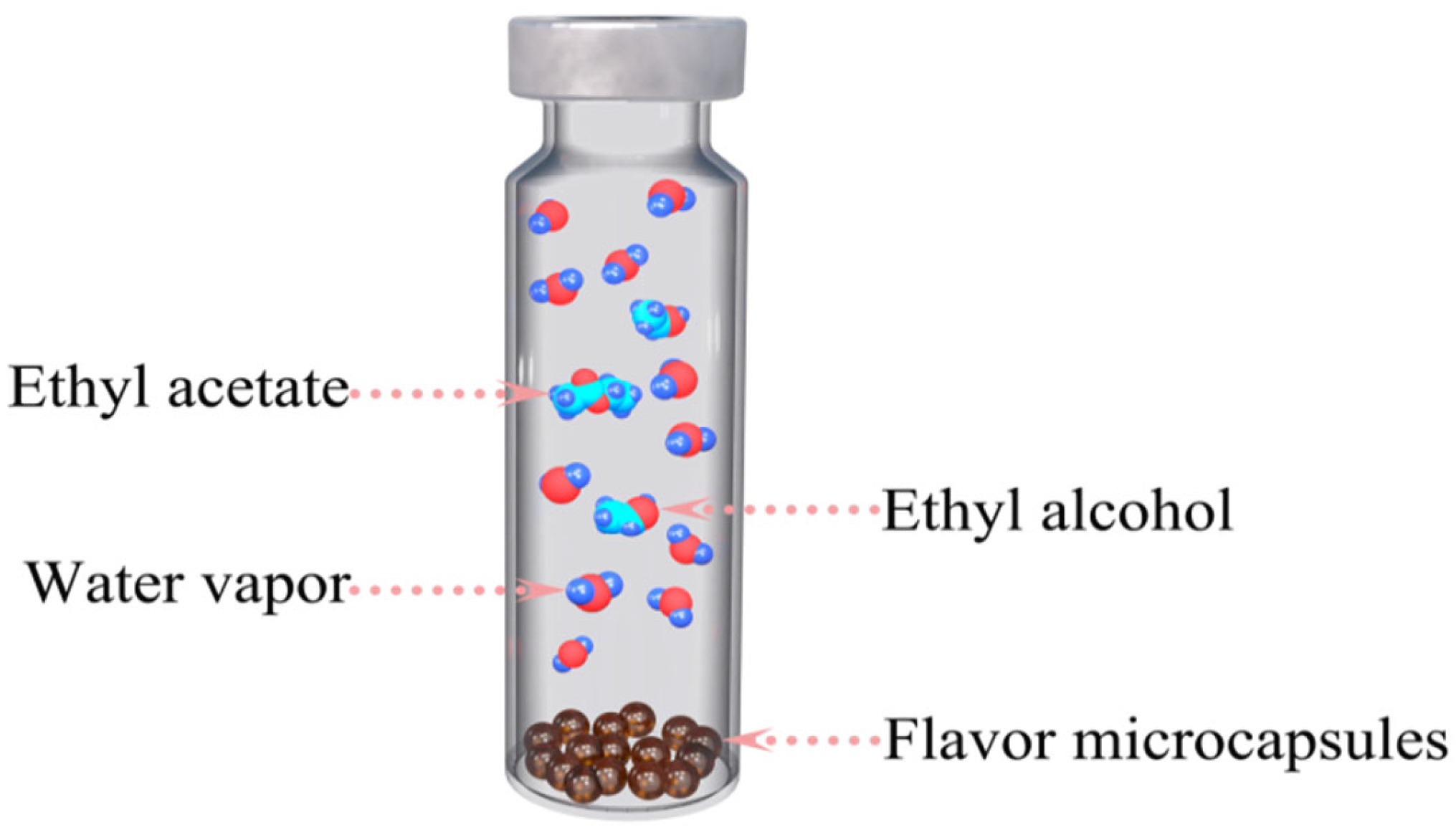
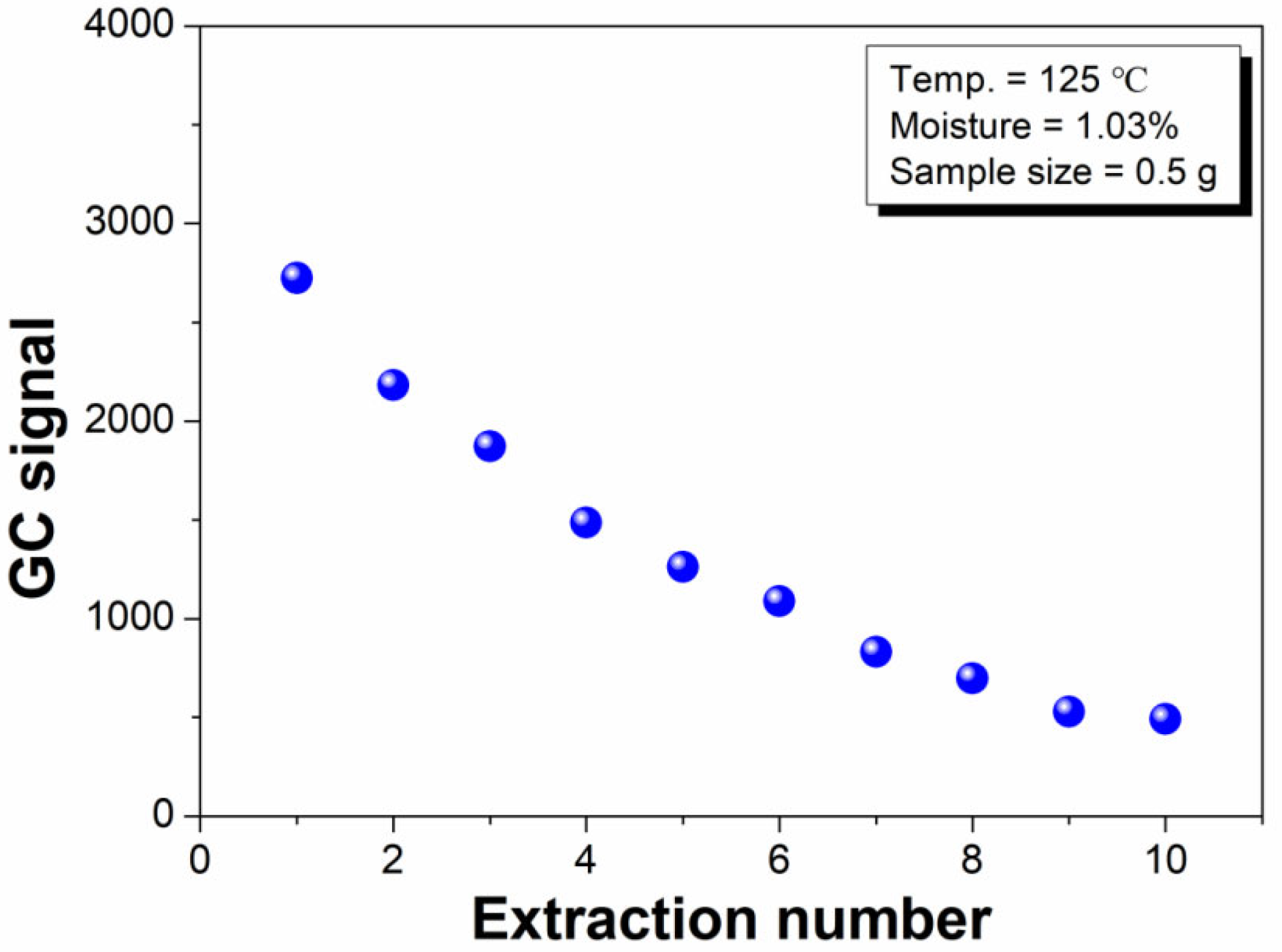
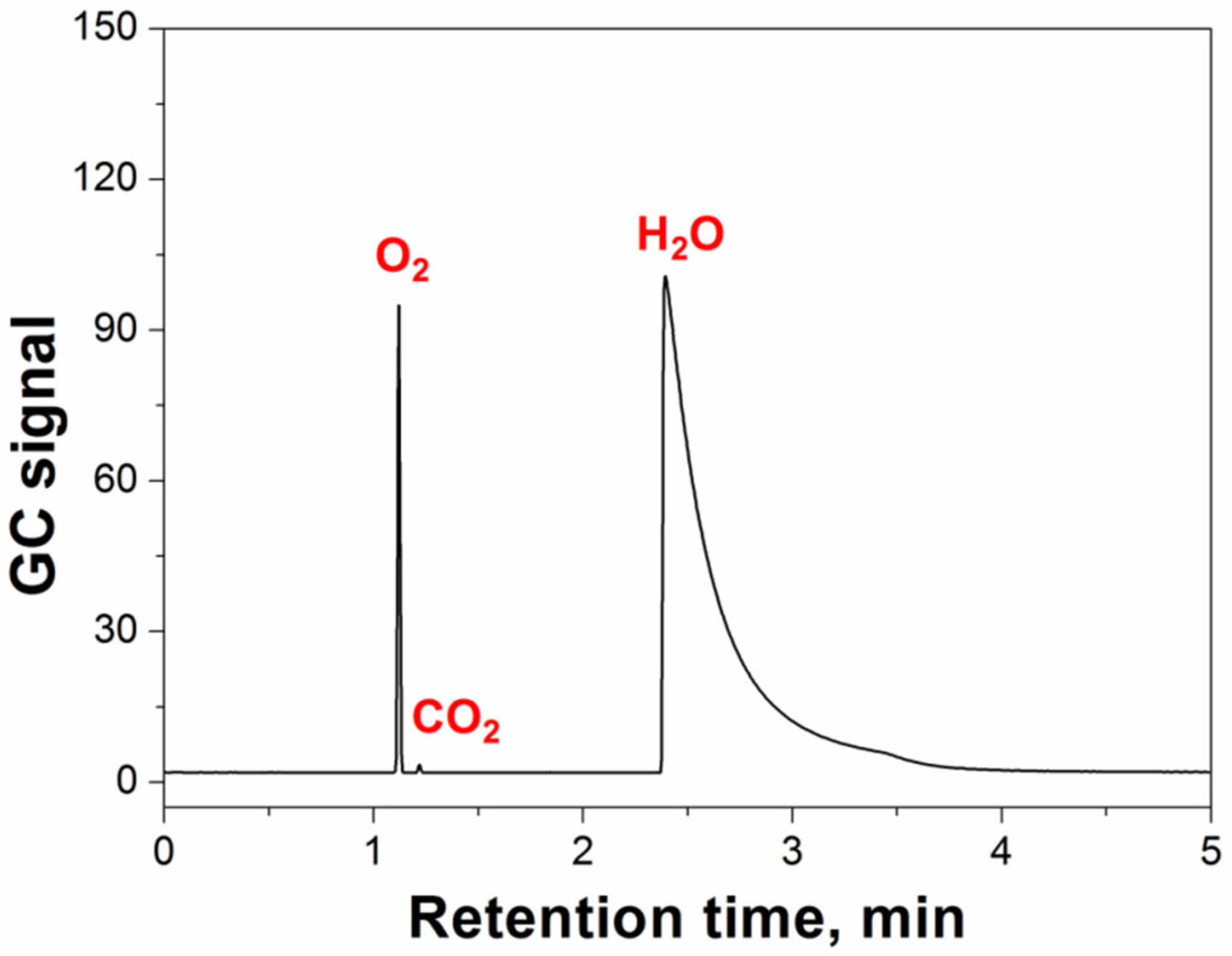
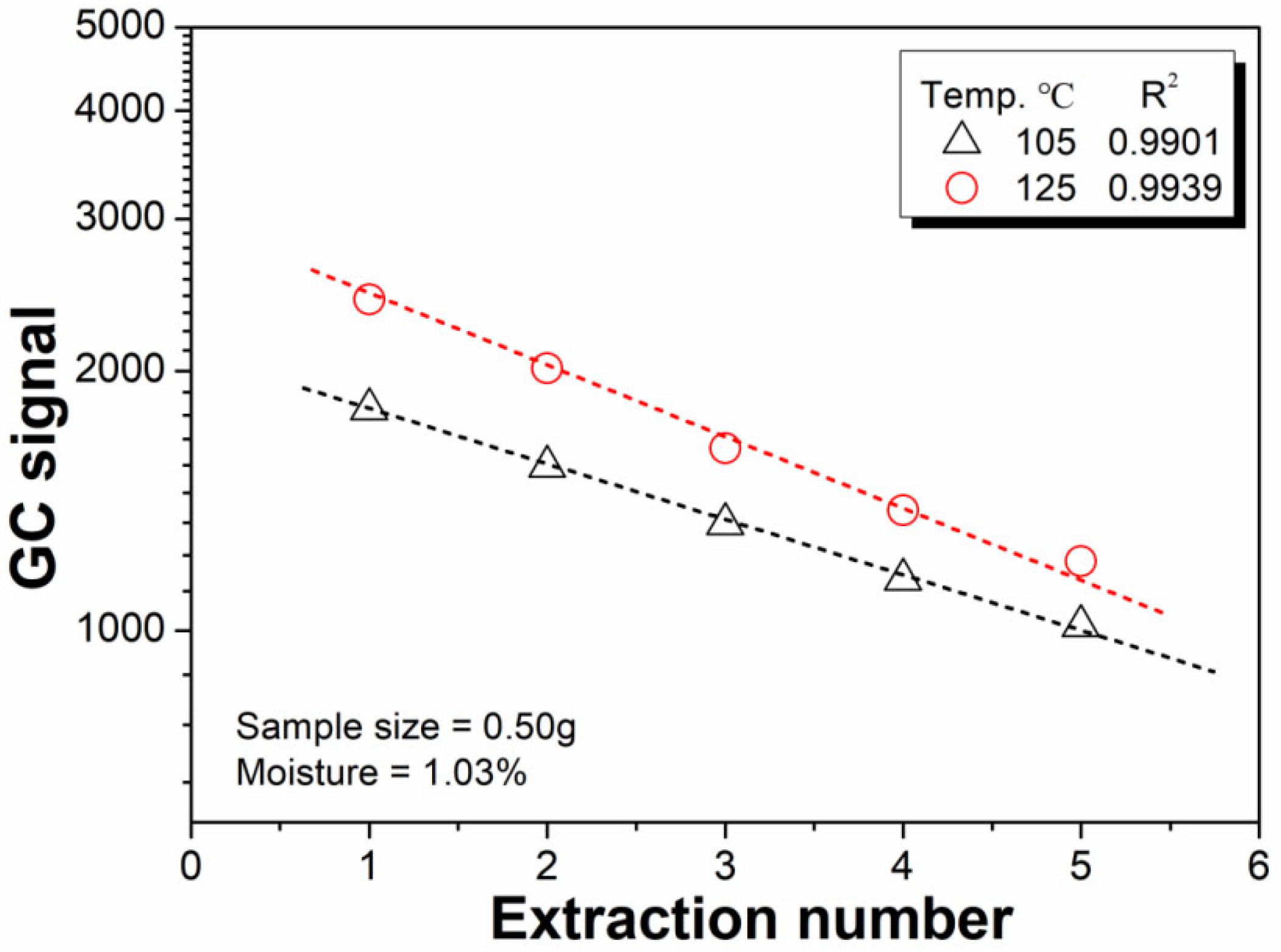
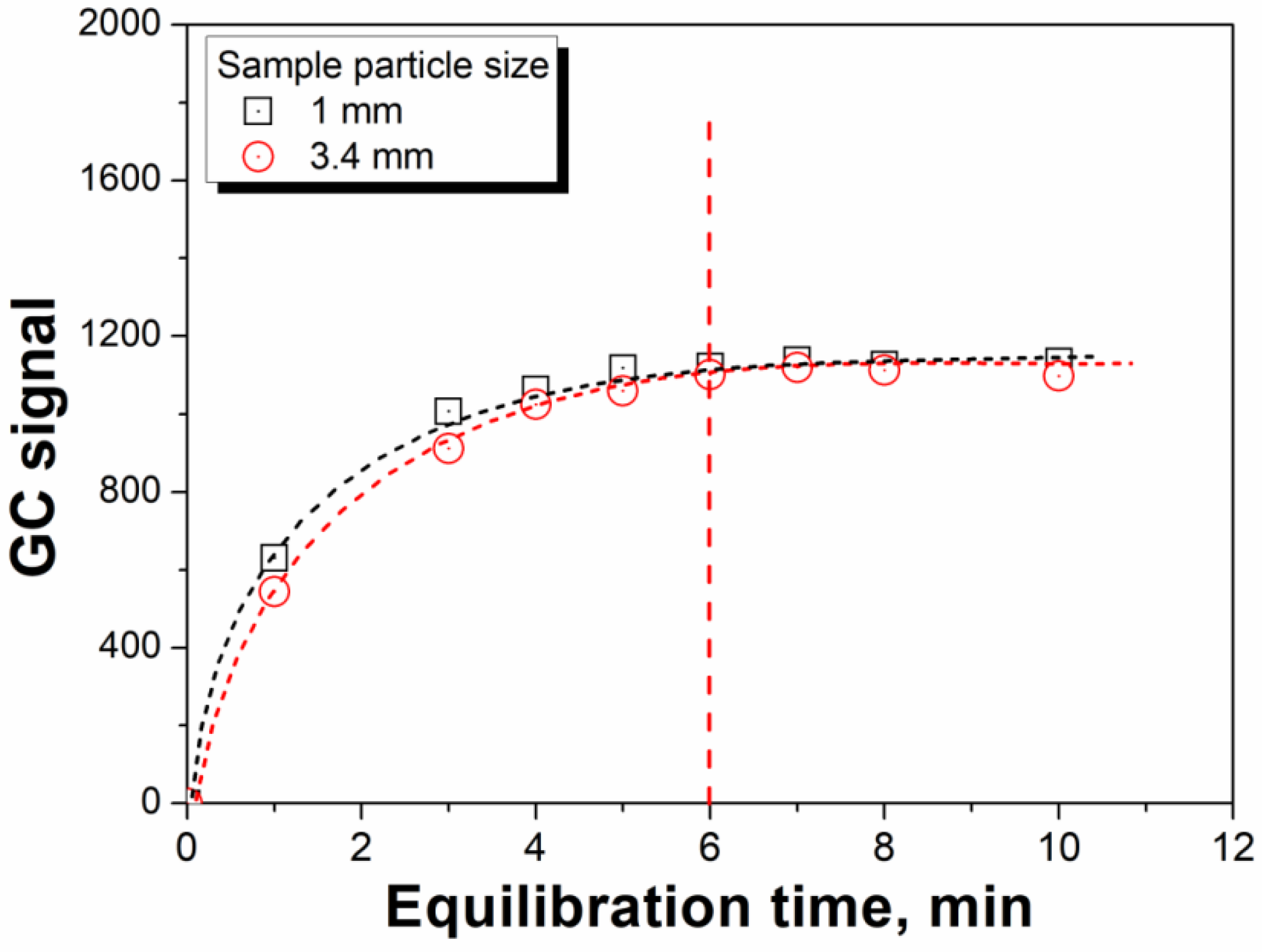
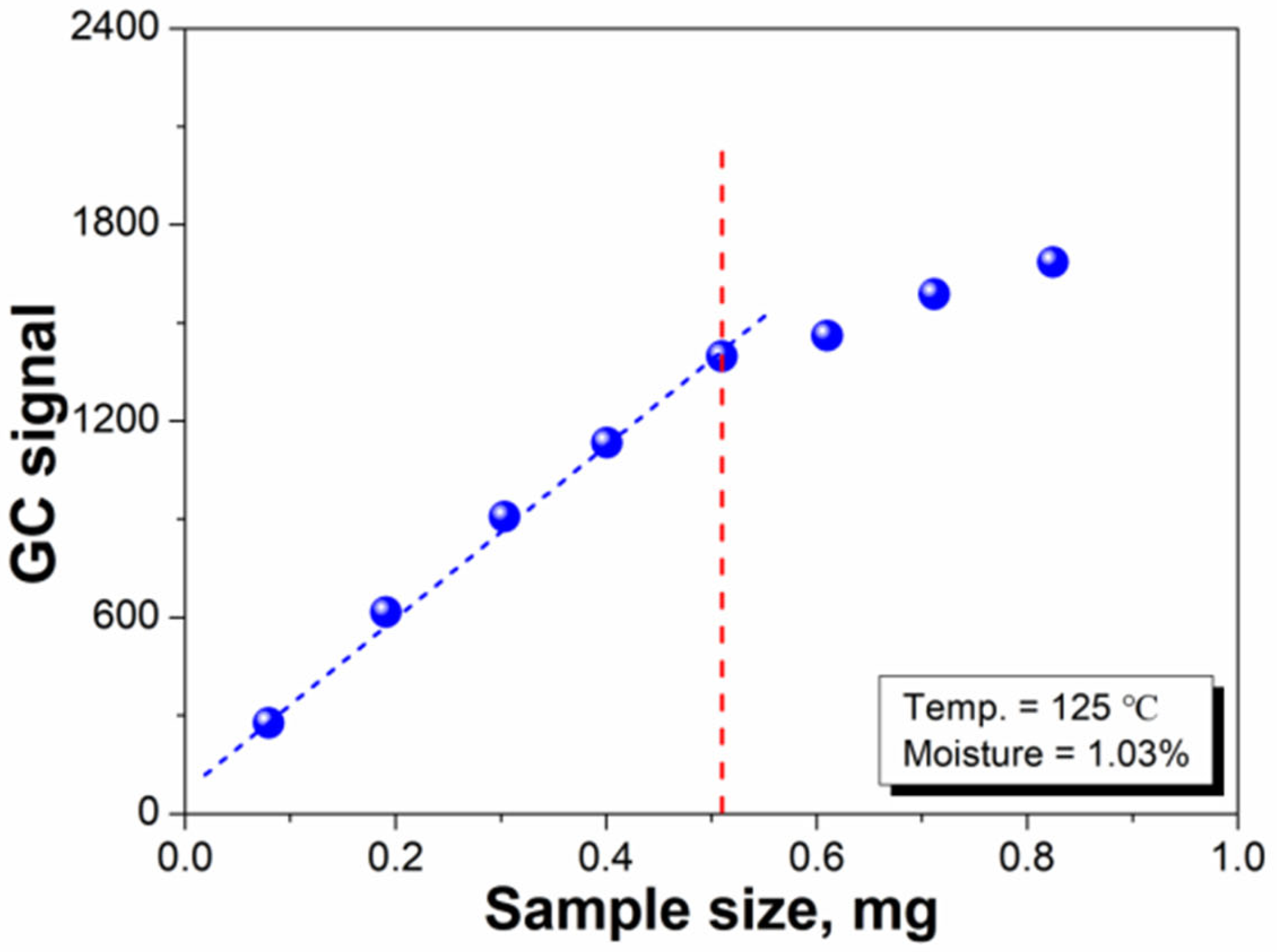
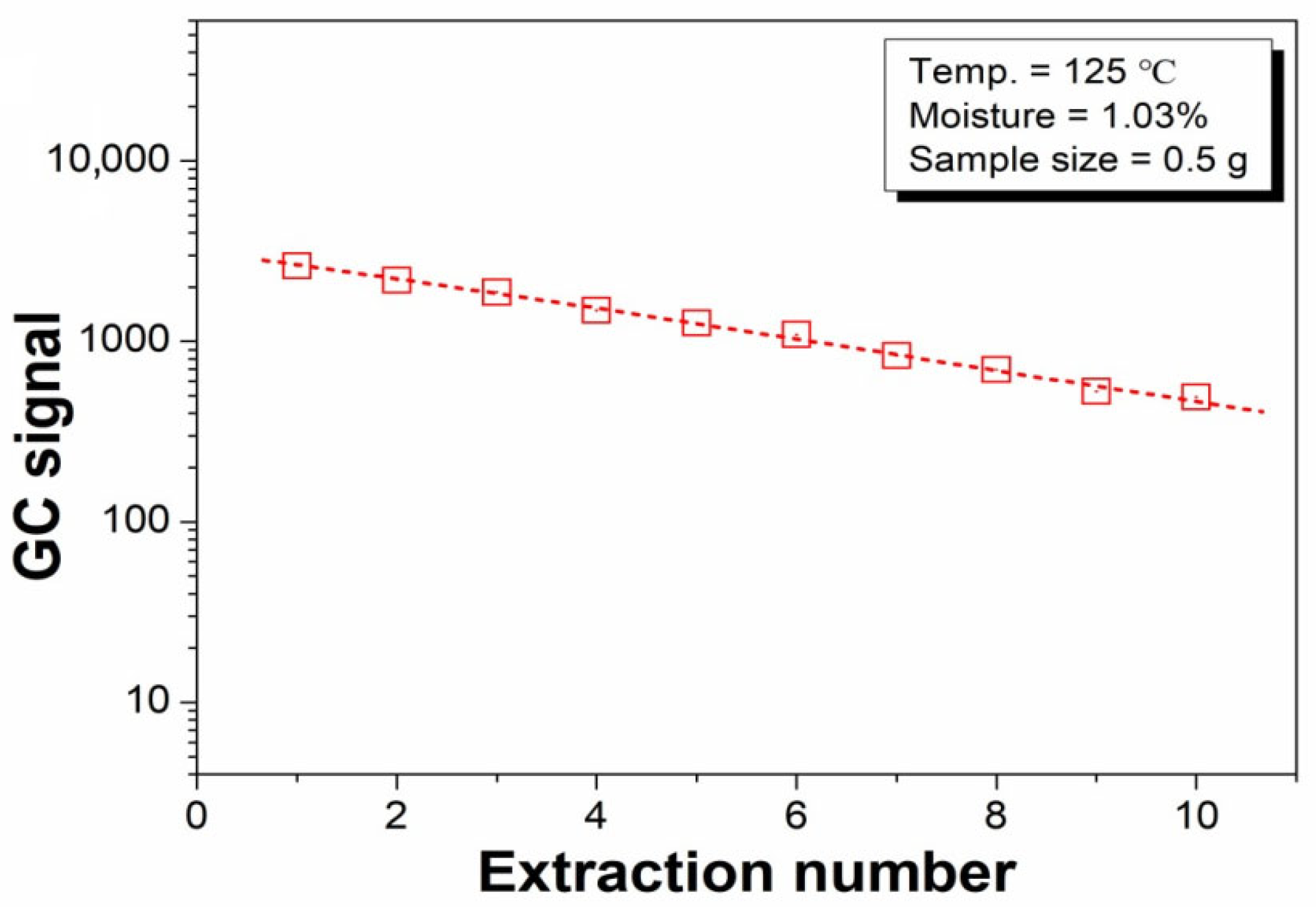
| Replica No. | Water Content, % | ||
|---|---|---|---|
| Sample 1 | Sample 2 | Sample 3 | |
| 1 | 1.50 | 1.13 | 1.74 |
| 2 | 1.57 | 1.2 | 1.71 |
| 3 | 1.56 | 1.15 | 1.68 |
| RSD, % | 2.45 | 3.11 | 1.75 |
| Sample ID | Water Content, % | Relative Error, % | |||
|---|---|---|---|---|---|
| Low Temperature Dry Nitrogen Purge Method (n = 3) | Oven Drying Method (n = 3) | MHE-GC (n = 3) | Low Temperature Dry Nitrogen Purge Method | Oven Drying Method | |
| 1 | 0.86 ± 0.01 | 1.01 ± 0.02 | 0.87 ± 0.02 | 1.16 | −13.9 |
| 2 | 1.12 ± 0.01 | 1.32 ± 0.01 | 1.08 ± 0.01 | −3.57 | −18.2 |
| 3 | 1.40 ± 0.02 | 1.66 ± 0.03 | 1.35 ± 0.02 | −3.57 | −18.7 |
| 4 | 1.66 ± 0.02 | 1.93 ± 0.02 | 1.64 ± 0.02 | −1.20 | −15.0 |
| 5 | 1.99 ± 0.03 | 2.14 ± 0.03 | 2.06 ± 0.02 | 3.52 | −3.7 |
| 6 | 1.09 ± 0.03 | 1.38 ± 0.02 | 1.03 ± 0.01 | −5.50 | −25.4 |
| 7 | 2.13 ± 0.01 | 2.36 ± 0.03 | 2.05 ± 0.01 | −3.76 | −13.1 |
Publisher’s Note: MDPI stays neutral with regard to jurisdictional claims in published maps and institutional affiliations. |
© 2022 by the authors. Licensee MDPI, Basel, Switzerland. This article is an open access article distributed under the terms and conditions of the Creative Commons Attribution (CC BY) license (https://creativecommons.org/licenses/by/4.0/).
Share and Cite
Liu, X.; Zhu, C.; Yu, K.; Li, W.; Luo, Y.; Dai, Y.; Wang, H. Accurate Determination of Moisture Content in Flavor Microcapsules Using Headspace Gas Chromatography. Polymers 2022, 14, 3002. https://doi.org/10.3390/polym14153002
Liu X, Zhu C, Yu K, Li W, Luo Y, Dai Y, Wang H. Accurate Determination of Moisture Content in Flavor Microcapsules Using Headspace Gas Chromatography. Polymers. 2022; 14(15):3002. https://doi.org/10.3390/polym14153002
Chicago/Turabian StyleLiu, Xueyan, Chuxing Zhu, Kang Yu, Wei Li, Yingchun Luo, Yi Dai, and Hao Wang. 2022. "Accurate Determination of Moisture Content in Flavor Microcapsules Using Headspace Gas Chromatography" Polymers 14, no. 15: 3002. https://doi.org/10.3390/polym14153002
APA StyleLiu, X., Zhu, C., Yu, K., Li, W., Luo, Y., Dai, Y., & Wang, H. (2022). Accurate Determination of Moisture Content in Flavor Microcapsules Using Headspace Gas Chromatography. Polymers, 14(15), 3002. https://doi.org/10.3390/polym14153002






